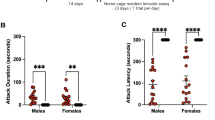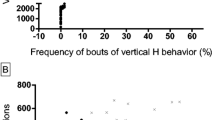Abstract
Treatment with a number of phenylpiperazine drugs induces a selective inhibition of attack behavior during resident-intruder encounters which has been interpreted as reflecting a drug-induced “serenic” state. Treatment with two well-characterized anxiogenic compounds (yohimbine, FG 7142), however, also closely mimicked the effects of phenylpiperazines on such attack. In addition, studies with two of the serenics revealed that they increased avoidance induced by novel stimuli (fluprazine) and/or nonaggressive conspecifics (fluprazine and eltoprazine). These data not only suggest that phenylpiperazines may be more properly characterized as anxiogenic, but the data also bring into question the usefulness of behavioral profiles derived exclusively from resident-intruder tests to infer anxiolytic or anxiogenic drug actions. Novelty-induced tearfulness is suggested to provide a useful instrument for the detection of generalized anxiolytic or anxiogenic effects whereas nonagonistic social interactions reveal more specific drug effects on reactivity to conspecifics. In addition, the fact that the attack-suppressing effects of fluprazine and yohimbine are also accompanied by increased sniffing behavior and altered conspecific odor preferences strongly suggests the need for a careful examination of olfactory function in the assessment of any putative antiaggressive drug.
Similar content being viewed by others
References
ALBERTS, J. R., & GALEF, B. G. (1971). Acute anosmia in the rat: A behavioral test of a peripherally induced olfactory deficit. Physiology and Behavior, 6, 619–621.
BECK, C. H. M., & COOPER, S. J. (1986). The effects of the ß-carboline FG 7142 on the behaviour of male rats in a living cage: An ethological analysis of social and nonsocial behaviour. Psychopharmacology, 89, 203–207.
BENTON, D., BRAIN, P., JONES, S., COLEBROOK, E., & GRIMM, V. (1983). Behavioural examinations of the anti-aggressive drug fluprazine. Behavioural Brain Research, 10, 325–328.
BLANCHARD, D. C., TAKUSHI, R., BLANCHARD, R. J., FLANNELLY, K. J., & KEMBLE, E. D. (1985). Fluprazine hydrochloride does not decrease defensive behaviors of wild and septal syndrome rats. Physiology and Behavior, 35, 349–353.
BLANCHARD, R. J., & BLANCHARD, D. C. (1977). Aggressive behaviour in the rat. Behavioral Biology, 21, 197–224.
BLANCHARD, R. J., BRAIN, P. F., BLANCHARD, D. C., & PARMIGIANI, S. (Eds.). (1989). Ethoexperimental approaches to the study of behavior, Dordrecht: Martinus Nijhoff.
BLANCHARD, R. J., FUKUNAGA, K., BLANCHARD, D. C., & KELLY, M. J. (1975). Conspecific aggression in the laboratory rat. Journal of Comparative and Physiological Psychology, 89, 1204–1209.
BLANCHARD, R. J., KELLY, M. J., & BLANCHARD, D. C. (1974). Defensive reactions and exploratory behavior in rats. Journal of Comparative and Physiological Psychology, 87, 1129–1133.
BLANCHARD, R. J., KLEINSCHMIDT, C. K., FLANNELLY, K. J., & BLANCHARD, D. C. (1984). Fear and aggression in the rat. Aggressive Behavior, 10, 309–315.
BLANCHARD, R. J., O’DONNELL. V., & BLANCHARD, D. C. (1979). Attack and defensive behavior in the albino mouse. Aggressive Behavior, 5, 341–352.
BOWER, D. C. (1979). Mousekilling, intermale fighting and conditioned emotional response in rats. Aggressive Behavior, 5, 41–49.
BRADFORD, L. D., OLIVIER, B., VAN DALEN, D., & SCHIPPER, J. (1984). Serenics: The pharmacology of fluprazine and DU 28412. In K. Miczek, A. Kruk, & B. Olivier (Eds.), Ethnopharmacological aggression research, (pp. 191–207). New York: Alan R. Liss.
CHARNEY, D. S., HENINGER, G. R., & STERNBERG, D. E. (1982). Assessment of alpha-2-adrenergic autoreceptor functions on humans: Effects of oral yohimbine. Life Sciences, 30, 2033–2041.
DAVIS, M., REDMOND, D. E., & BARABAN, J. M. (1979). Noradrenergic agonists and antagonists: Effects on conditioned fear as measured by the potentiated startle paradigm. Psychopharmacology, 65, 111–118.
DEPAULIS, A., & VERGNES, M. (1983). Relationship between mousekelling and conspecific aggression in the male rat. Aggressive Behavior, 9, 259–268.
DIXON, A. K. (1982). A possible olfactory component in the effects of diazepam on social behavior of mice. Psychopharmacology, 77, 246–252.
DOROW, R., HOROWSKI, R., PASCHELKE, G., AMIN, A. & BRAESTRUP, C. (1983). Severe anxiety induced by FG 7142, a ß-carboline ligand for benzodiazepine receptors. The Lancet, July, 98–99.
FILE, S. E. (1980). The use of social interaction as a method for detecting anxiolytic activity of chlordiazepoxide-like drugs. Journal of Neuroscience Methods, 2, 219–238.
FILE, S. E. (1986). Aversive and appetitive properties of anxiogenic and anxiolytic agents. Behavioural Brain Research, 21, 189–194.
FILE, S. E., & JOHNSTON, A. L. (1987). Chronic treatment with imipramine does not reverse the effects of 3 anxiogenic compounds in a test of anxiety in the rat. Pharmacopsychiatry, 17, 187–192.
FILE, S. E., & PELLOW, S. (1984). The anxiogenic action of FG 7142 in the social interaction test is reversed by chlordiazepoxide and Ro 15-1788 but not by CGS 8216. Archives Internationales de Pharmacodynamie, 271, 198–205.
FLANNELLY, K. J., & BLANCHARD, R. J. (1982). Decreased aggressive and social responsiveness of chronically anosmic rats. Bulletin of the Psychonomic Society, 19, 173.
FLANNELLY, K. J., BLANCHARD, R. J., & BLANCHARD, D. C. (Eds). (1984). Biological perspectives on aggression. New York: Alan R. Liss.
FLANNELLY, K. J., HIRAOKA, A., & FLANNELLY, L. (1981). Prolonged suppressive effects of pain on territorial aggression in mice. Psychological Reports, 51, 52–54.
FLANNELLY, K. J., MURAOKA, M. Y., BLANCHARD, D. C., & BLANCHARD, R. J. (1985). Specific anti-aggressive effects of fluprazine hydrochloride. Psychopharmacology, 87, 86–89.
GUY, A. P., & GARDNER, C. R. (1985). Pharmacological characterisation of a modified social interaction model of anxiety in the rat. Neuropsychobiology, 13, 194–200.
HARRIS, J. C., & NEWMAN, J. D. (1987). Mediation of separation distress by alpha-adrenergic mechanisms in a non-human primate. Brain Research, 410, 353–356.
KEMBLE, E. D., BEHRENS, M., RAWLEIGH, J. M., & GIBSON, B. M. (1990). [Effects of yohimbine on isolation-induced aggression, exploration, social attraction and olfactory preference]. Unpublished data.
KEMBLE, E. D., FLANNELLY, K. J., SALLEY, H., & BLANCHARD, R. J. (1985). Mouse killing, insect predation, and conspecific attack by rats with differing prior aggressive experience. Physiology and Behavior, 34, 645–648.
KEMBLE, E. D., GIBSON, B. M., & RAWLEIGH, J. M. (1990). Effects of eltoprazine hydrochloride on exploratory behavior and social attraction in mice. Pharmacology Biochemistry and Behavior, in press.
KEMBLE, E. D., MEEK, L. R., & GIBSON, B. M. (1989). Effects of fluprazine hydrochloride on three aversively motivated tasks. The Psychological Record, 39, 573–581.
KEMBLE, E. D., SCHULTZ, L. A., & THORNTON, A. E. (1986). Effects of fluprazine hydrochloride on conspecific odor preferences in rats. Physiology and Behavior, 37, 53–56.
KEMBLE, E. D., THORNTON, A. E., & SCHULTZ, L. A. (1987). Some fear-potentiating effects of fluprazine hydrochloride in mice. Aggressive Behavior, 13, 269–280.
LATANÉ, B., CAPPELL, H., & JOY, V. (1970). Social deprivation, housing density, and gregariousness in rats. Journal of Comparative and Physiological Psychology, 70, 221–227.
LATANÉ, B., JOY, V., MELTZER, J., LUBELL, B., & CAPPELL, H. (1972). Stimulus determinants of social attraction in rats. Journal of Comparative and Physiological Psychology, 79, 13–21.
LATANÉ, B., NESBITT, P., ECKMAN, J., & RODIN, J. (1972). Long- and short-term social deprivation and sociability in rats. Journal of Comparative and Physiological Psychology, 81, 69–75.
MEEK, L. R., GIBSON, B. M., & KEMBLE, E. D. (1989). Effects of fluprazine hydrochloride on reactivity to a nonconspecific intruder. The Psychological Record, 39, 203–210.
MICZEK, K., KRUK, M., & OLIVIER, B. (Eds.). (1984). Ethopharacological aggression research (pp. 157–177). New York: Alan Liss.
OLIVIER, B. (1981). Selective anti-aggressive properties of DU 27725: Ethological analyses of intermale and territorial aggression in the male rat. Pharmacology Biochemistry and Behavior, 14, 61–77.
OLIVIER, B., & MOS, J. (1989). Serotonin, serenics and aggressive behavior in animals. In J. Swinkels & W. Blijleven (Eds.), Depression, anxiety and aggression (pp. 133-165). Houten: Medidact.
OLIVIER, B., MOS, J., & BRAIN, P. F. (1987). Ethopharmacology of agonistic behaviour in animals and humans. In B. Olivier, J. Mos, M. Tulp, B. Berkelmans, & P. Bevans (Eds.), Serotonergic modulation of agonistic behaviour (pp. 162–186). Dordrecht: Martinus Nijhoff.
OLIVIER, B., MOS, J., VAN DER HEYDEN, J., & HARTOG, J. (1989). Serotonergic modulation of social interactions in isolated male mice. Psychopharmacology, 97, 154–156.
OLIVIER, B., MOS, J., VAN DER POEL, A. M., KRIJZER, P. N. C., & KRUK, M. R. (1984). Effects of a new psychoactive drug (DU 27716) on different models of rat agonistic behaviour and EEG. In K. J. Flannelly, R. J. Blanchard, & D. C. Blanchard (Eds.), Biological perspectives on aggression (pp. 261–279). New York: Alan R. Liss.
OLIVIER, B., VAN DALEN, D., & HARTOG, J. (1986). A new class of psychotropic drugs: Serenics. Drugs of the Future, 11, 473–494.
OSBORNE, G. L. (1977). Differences in locomotor activity between rats and gerbils in response to novelty. Behavioral Biology, 19, 548–553.
PELLOW, S., CHOPIN, P., FILE, S. E., & BRILEY, M. (1985). Validation of open:closed arm entries in an elevated plus-maze as a measure of anxiety in the rat. Journal of Neuroscience Methods, 14, 149–167.
PELLOW, S., & FILE, S. E. (1986). Anxiolytic and anxiogenic drug effects of exploratory activity in an elevated plus-maze: A novel test of anxiety in the rat. Pharmacology Biochemistry and Behavior, 24, 525–529.
RACINE, M. A., FLANNELLY, K. J., & BLANCHARD, D. C. (1984). Antiaggressive effects of Du 27716 on attack and defensive behavior in the albino mouse. In K. J. Flannelly, R. J. Blanchard, & D. C. Blanchard (Eds.), Biological perspectives on aggression (pp. 281–293). New York: Alan R. Liss.
RAWLEIGH, J. M., & KEMBLE, E. D. (1990). [Effects of FG 7142 on isolation-induced aggression in mice]. Unpublished data.
RODGERS, R. J., & RANDALL, J. I. (1986). Resident’s scent: A critical factor in acute analgesic reaction to defeat experience in male mice. Physiology and Behavior, 37, 317–322.
RODGERS, R. J., & WATERS, A. J. (1985). Benzodiazepines and their antagonists: A pharmacoethological analysis with particular reference to effects on “aggression.” Neuroscience and Biobehavioral Reviews, 9, 21–35.
SCHULTZ, L. A., & KEMBLE, E. D. (1986). Prey-dependent effects of fluprazine hydrochloride on predatory aggression in northern grasshopper mice (Onychomys leucogaster) and rats (Rattus norvegicus). Aggressive Behavior, 12, 267–275.
ŠULCOVÁ, A., & KRŠIAK, M. (1986). ß-carbolines (ß-CCE, FG 7142) and diazepam: Synergistic effects on aggression and antagonistic effects on timidity in mice. Activitus Nervosa Superior (Praha), 28, 312–313.
TAKAHASHI, L. K., & BLANCHARD. R. J. (1982). Attack and defense in laboratory and wild norway and black rats. Behavioural Processes, 7, 49–62.
THOR, D. H., & FLANNELLY, K. J. (1977). Peripheral anosmia and social investigatory behavior of the male rat. Behavioral Biology, 20, 128–134.
WILLIAMS, J. L. (1987). Influence of conspecific stress odors and shock controllability on conditioned defensive burying. Animal Learning and Behavior, 15, 333–341.
WILLIAMS, J. L., & SCOTT, D. K. (1989). Influence of conspecific and predatory stressors and the associated odors on defensive burying and freezing. Animal Learning & Behavior, 17, 383–393.
WILLLIAMS, J. L., WORLAND, P. D., & SMITH, M. G. (1990). Defeat-induced hypoalgesia in the rat: Effects of conditioned odors, naltrexone, and extinction. Journal of Experimental Psychology: Animal Behavior Processes, 16 (4), 345–357.
Author information
Authors and Affiliations
Additional information
We thank B. Olivier who kindly supplied the fluprazine and eltoprazine used in these experiments.
Rights and permissions
About this article
Cite this article
Kemble, E.D., Rawleigh, J.M. Resident-Intruder Paradigms and Antiaggressive Drugs: Some Further Data. Psychol Rec 41, 255–269 (1991). https://doi.org/10.1007/BF03395109
Published:
Issue Date:
DOI: https://doi.org/10.1007/BF03395109




